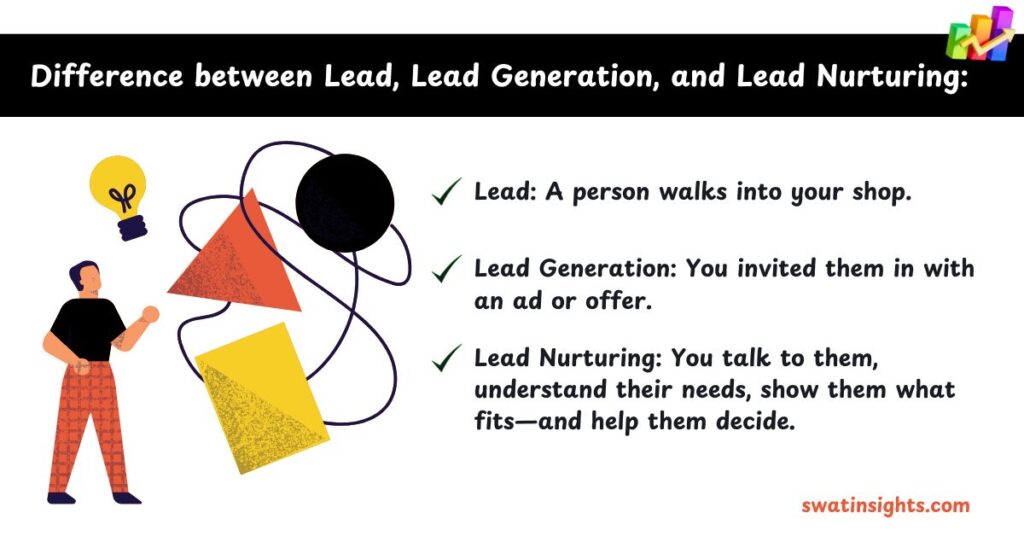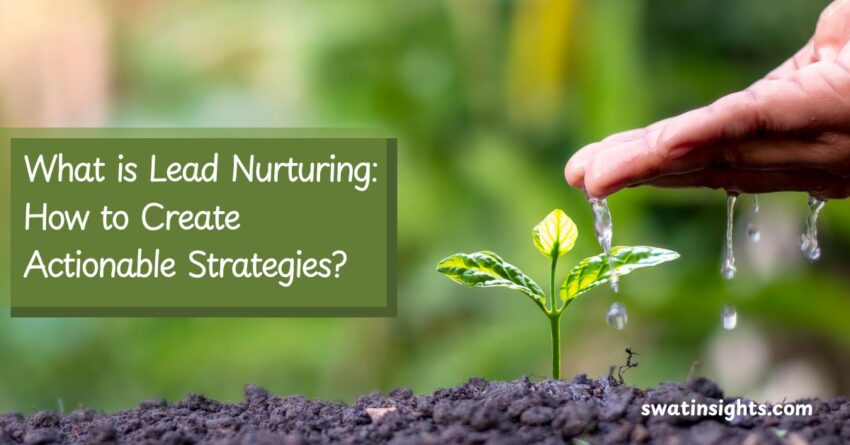You Got the Leads. Now What?
You run the ads. You created a lead magnet. The forms are filling up.
Great! But they are not buying.
If this sounds familiar, you are not alone.
Converting leads into customers requires nurturing: Thoughtfully, consistently, and strategically.
In a world of information overload, your prospects need more than just another sales email.
They need content that builds trust, answers their hesitations, and guides them toward action.
What is Lead Nurturing?
Lead nurturing builds trust and guides your leads toward making a purchase.
It’s about educating, engaging, and staying connected with your leads over time.
Common nurturing tactics:
- Sending follow-up emails with value
- Sharing testimonials, case studies, or product benefits
- Answering doubts or objections
- Offering a special deal at the right time.
Lead nurturing is how you turn a maybe into a yes.

Why Most Businesses Ignore It?
Most businesses stop at We got the lead!
Leads do not turn into customers just because you followed up once. Or because they downloaded your ebook.
Some leads do not need pushing.
They need content, clarity, and confidence.
You must ask:
- Do they know they have a problem?
- Do they trust your solution?
- Are you solving what is stopping them?
Lead Nurturing ≠ More Emails. It is About More Trust.
Most leads are not ignoring you. They are just not ready yet.
Your job is not to convince everyone immediately.
It is to guide them gently with empathy and relevance.
That means:
- Understanding their stage of awareness.
- Creating the right content for that stage.
- Sending it in the format (email, video, guide, testimonial, etc.) at the right time.
- Using on-page SEO techniques to attract and convert inbound leads.
Lead Nurturing Strategy of different Industries
Different industries need different approaches. What works for SaaS might not work for fashion or education.
Stop guessing and start converting.
1. B2B / SaaS
Lead Stage: People attended your demo but did not convert.
What this means: They were curious enough to book a demo. But they might still be comparing competitors, unclear on value, or unsure about ROI.
What to do:
- Send a Product Comparison PDF to highlight your strengths vs. alternatives.
- Share a case study from their industry showing how your tool solved a similar problem.
- Record a personalized video addressing objections like pricing, integration, or support.
- Include an ROI calculator to help them visualize the return on investment.
- Share testimonials from key decision-makers in similar companies.
2. E-learning / Coaching
Lead Stage: Downloaded a free guide or attended a free masterclass.
What this means: Students are curious about your course. But they are not sure if it is the right choice for them yet.
What to do:
- Send short video clips from your course (so they can see the quality and content).
- Share transformation stories and before-after results.
- Offer a sneak peek of the curriculum or module breakdown.
- Send behind-the-scenes mentor calls or student community.
- Address objections like time, cost, and self-doubt through video/email.
Challenges of Online Education and Ways to improve it.
3. Marketing Agencies
Lead Stage: Replied to a discovery email or connected on LinkedIn.
What this means: They are interested but want proof of value.
What to do:
- Share a 1-minute website or ad audit in video format (show you did your homework).
- Send a tailored proposal or strategic framework not generic pitches.
- Share 2–3 case studies from similar businesses with quantifiable outcomes.
- Offer a free mini strategy call to show you bring value.
- Address common fears:
- Will this work for my niche?
- What if it fails?
Marketing, Sales, and Branding: The Differences That Drive Growth
4. Retail / E-commerce
Lead Stage: Potential customer added to cart but did not make a purchase.
What this means: They liked the product but got distracted, hesitant, or unsure about its value.
What to do:
- Send a cart reminder email with a limited-time discount.
- Add user reviews of the product to the email.
- Address FAQs like size, delivery, return policy, etc.
- Include a Still thinking?
- Send follow-up messages, and you might also like suggestions.
- Test exit-intent popups on your site offer small incentives to return.
5. Higher Education / Universities
Lead Stage: Filled out a form but did not take the next step.
What this means: The audience is interested in the course but needs clarity on future outcomes, credibility, or financial aid.
What to do:
- Share student success stories—before and after placement data.
- Send detailed program brochures with faculty credentials.
- Offer virtual campus tours or Q&A sessions.
- Create a student guide answering the top 10 FAQs (fees, placements, scholarships).
- Use remarketing ads with testimonials and course highlights.
6. Travel & Hospitality
Lead Stage: They browsed packages but did not book.
What this means: Potential clients are dreaming about a trip but need more personalization or better reasons to book now.
What to do:
- Send a custom itinerary based on their browsing.
- Include video testimonials from past travelers.
- Highlight flexible booking and free cancellations.
- Offer limited-time seasonal discounts.
- Use WhatsApp or email for personalized support.
7. Fashion & Apparel
Lead Stage: Visited your site multiple times or followed on Instagram.
What this means: They are drawn to your brand but need a nudge, either emotional or logical.
What to do:
- Share style guides that help them imagine outfits (e.g., Five ways to wear this top).
- Offer exclusive early access to new drops or flash sales.
- Send a Find Your Style quiz to personalize product suggestions.
- Highlight social proof influencers or happy customer photos.
- Run retargeting ads with items they viewed or added to wishlists.
Final Thoughts:
Lead nurturing is not about sending random emails.
It is about solving doubts at the right moment and with the right message.
Want more conversions?
Do not just collect leads. Care for them.
Because once they trust you, they will buy from you and keep coming.
Frequently Asked Questions
1. What is Lead?
A lead is a potential customer shown interest in your product or service.
Example:
- Someone who fills out a form on your website,
- downloads a free guide,
- or sign up for a demo.
2. What is Lead Generation?
Lead generation is the process of attracting and capturing leads.
The goal is to get potential customers to raise their hands and show interest.
3. What are Common ways to generate leads:
- Running Facebook or Google Ads.
- Offering a free eBook or checklist.
- Hosting webinars or events.
- SEO/blog traffic that leads to signups.
Lead generation is how you find and attract people who might want what you offer.

1 thought on “What is Lead Nurturing: How to Create Actionable Strategies?”